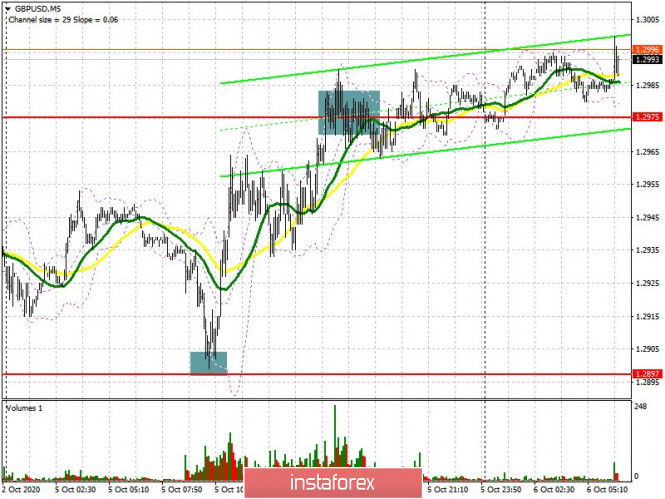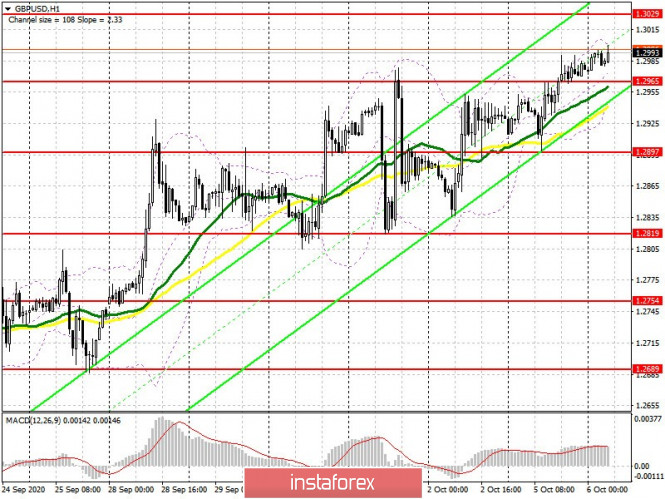
To open long positions on GBP/USD, you need:
Buyers of the pound managed to rebound off the support level of 1.2897 in the first half of the day, following the release of a pretty good final indicator on the activity of the UK services sector. I paid attention to the 1.2897 level in yesterday's morning forecast and advised you to open long positions from it. Unfortunately, if you look at the 5-minute chart, you will see that it was not possible to achieve any signal from the 1.2975 level in the afternoon. This range was completely blurred, which forced me to revise it in today's forecast.

An important task for the pound buyers is to protect support at 1.2965 today. As long as trading is conducted above this range, there is a fairly high chance that the pound will continue to grow in the short term. Forming a false breakout at the 1.2965 level in the first half of the day forms another buy signal. It is likely that this may happen after the release of data on activity in the UK construction sector. The bulls will immediately aim for resistance at 1.3029, consolidating on it forms an additional entry point to long positions while expecting to update a large high at 1.3089, where I recommend taking profits. If the pound is under pressure again and the pair drops below the 1.2965 level, where the moving averages playing on the side of the bulls also pass, then it is best not to rush to open long positions, but to wait until GBP/USD falls to the support area of 1.2897. Forming a false breakout there will be a signal to buy the pound. It is best to open long positions immediately on a rebound from the 1.2819 low.
The Commitment of Traders (COT) reports for September 29 recorded a sharp rise in short positions and a reduction in long positions, which affected the net position and led to its larger negative value. This once again confirms the desire of traders to build up short positions with any growth in the level, counting on uncertainty over Brexit and the prospects for the recovery of the British economy. The pressure on the pound will gradually increase as the second wave of coronavirus spreads. Short non-commercial positions increased from 40,523 to 51,961 during the reporting week. Long non-commercial positions decreased from 43,487 to 39,216. As a result, the non-commercial net position became negative and reached -12,745, against 2,964 a week earlier, which indicates that control over the market is gradually returning to large sellers.
To open short positions on GBP/USD, you need:
Pound sellers have a very simple task. For the market to return to their side, GBP/USD must drop below the 1.2965 level. Testing this area from the bottom up forms a good entry point into short positions. In this case, the 1.2897 area will be the nearest target, breaking below which will not be so easy. If the bears succeed in doing this, the pressure on the pound may significantly increase, and more persistent sellers will wait for an update of the 1.2819 low, where I recommend taking profits, since large buyers were constantly entering from this range throughout the week, betting on the pound's growth. In case the pair grows in the first half of the day after the report on the construction sector in the UK, it is best not to rush to sell, but to wait until a high at 1.3029 has been updated, where a false breakout provides an entry point for short positions. Selling GBP/USD immediately on a rebound is best from the range of 1.3089, counting on a correction of 30-40 points within the day.

Indicator signals:
Moving averages
Trading is carried out above 30 and 50 moving averages, which indicates an attempt to build a new upward wave for the pound.
Note: The period and prices of moving averages are considered by the author on the H1 hourly chart and differs from the general definition of the classic daily moving averages on the daily D1 chart.
Bollinger Bands
A breakout of the upper border of the indicator in the 1.3000 area will increase the demand for the pound. A breakout of the lower boundary at 1.2940 will bring pressure back to the pair.
Description of indicators
Moving average (moving average, determines the current trend by smoothing out volatility and noise). Period 50. It is marked in yellow on the chart. Moving average (moving average, determines the current trend by smoothing out volatility and noise). Period 30. It is marked in green on the chart. MACD indicator (Moving Average Convergence/Divergence — convergence/divergence of moving averages) Quick EMA period 12. Slow EMA period to 26. SMA period 9 Bollinger Bands (Bollinger Bands). Period 20 Non-commercial speculative traders, such as individual traders, hedge funds, and large institutions that use the futures market for speculative purposes and meet certain requirements. Long non-commercial positions represent the total long open position of non-commercial traders. Short non-commercial positions represent the total short open position of non-commercial traders. Total non-commercial net position is the difference between short and long positions of non-commercial traders.